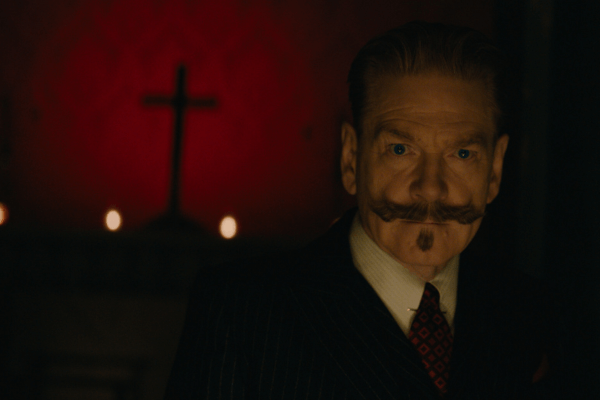“No god, no gods, no spirits,” declares Detective Hercule Poirot in A Haunting in Venice. “It’s only us.” Throughout the film, in theaters now, Poirot (Kenneth Branagh) points his ostentatious mustache at all manner of explanations to discredit the spiritualist Mrs. Reynolds (Michelle Yeoh) and her apparent powers of divination. But Poirot doesn’t just want to expose the alleged artifice of Mrs. Reynolds’ powers; he wants to reject any and all higher power. In a world so full of injustice, Poirot reasons, how could a just and powerful God exist?
A Haunting in Veniceis the third adaptation by Branagh, who also directs the film, of Agatha Christie’s Poirot novels (Murder on the Orient Express, Death on the Nile). The third installment follows the previous films’ mixture of popcorn entertainment and dour tone. A Haunting in Venice finds Poirot taking retirement badly, his joie de vivre sapped by a lack of mystery. That’s when mystery writer Ariadne Oliver (Tina Fey) arrives at Poirot’s door, inviting him to a Halloween party hosted by bereaved mother Rowena Drake (Kelly Reilly). At the party, Mrs. Reynolds is hosting a séance in hopes of contacting Drake’s departed daughter Alice (Rowan Robinson).
Although Branagh the actor restrains his performance, Branagh the director indulges every impulse, swirling the camera around the gothic setting and canting angles to almost induce seasickness.
During the séance scene, cinematographer Haris Zambarloukos trains his camera onto Mrs. Reynolds, who convulses wildly and takes on voices, spinning like a roulette wheel while accusing her killer. In reverse shots, we see each attendee stare back with horror, terrified that they will be revealed as the one who murdered Alice.
For the other attendees, Mrs. Reynolds’ spectacle proves the existence of spirits. While the results of Reynolds’s séance reveal that Alice died of foul play instead of natural causes, a certain peace fills several of the attendees. Even if the killer never gets caught, they suggest, at least they know that Alice is in a better place.
But for Poirot, peace cannot be separated from justice, certainly not a justice rooted in promises about another world. He believes that true comfort comes not in knowing that our loved ones are in heaven, but in stopping those who harm people and preventing suffering in the here and now. So, he puts his hands and eyes to work, finding the mechanical contraptions and co-conspirators who bring the séance to life.
With such cosmic stakes, Branagh does sometimes portray Poirot as an existential party pooper: The detective refuses to let Mrs. Reynolds and her guests take whatever comfort they can find in superstition or spirituality and browbeats anyone who doesn’t agree with him.
But when Branagh plays up the despair lurking inside Poirot, A Haunting in Venice illustrates the battle between doubt and faith. Poirot’s rational explanations may make sense of the murderer’s methods, but they fall short of explaining the problem of evil, driving the detective to succumb to nihilism.
Some Christian viewers may find that simply watching A Haunting in Venice presents its own challenge. As believers in God and as people who have faith in things not seen, we often align with Mrs. Reynolds and the others that Poirot aims to disprove. We fear that, at any second, Poirot will reach behind the pulpits of our church to reveal actors fooling us into believing in healed blind men and multiplied loaves.
But that can only be true of Christians who emphasize the spiritual realm of their faith while neglecting the bodily realm. Such an emphasis is a nearsighted approach to Christianity, as the very nature of Christianity is the belief that God took human form — that God had a body.
“Despite widespread tendencies to spiritualization, [the] basic materialist thrust of Christianity can be neither denied nor eliminated,” writes Dorothee Sölle in her essay “Between Matter and Spirit: Why and in What Sense Must Theology be Materialist?” As such, Christian discipleship means that followers must emulate Christ by addressing the real needs of the people in their time. “For incarnation means that God has entered precisely into sensuous and social reality and therefore he cannot be experienced outside of corporeality and society.”
Theologian Catherine Keller gets at a similar idea when she writes of intercarnations, the acts of embodied faith that Christians take to emulate Christ.
While some have dismissed the approaches of Sölle, Keller, and others as a rejection of God’s free gift of grace, the central tension in A Haunting in Venice shows that the two are interconnected. Branagh’s direction underscores the story’s setting shortly after World War II, with the devastation of the Jewish Holocaust and the U.S. nuclear attacks on Japan weighing heavily over all of the characters. The death of Drake’s innocent daughter serves as just one more meaningless act of suffering, which points to either a better world somewhere else or the complete absence of God.
But scripture reminds us that faith without works is dead (James 2:17). It presses us to show the reality of God’s great love for humanity not by ignoring the terrible things that occur, but by providing succor for the suffering and seeking justice for the oppressed.
Rarely is this type of lived faith as exciting as a flamboyant spook show, with mediums talking in strange voices. But embodied faith practices are such a powerful testimony that even the most rational mind must see how these works point to a loving and empowering God. As Christians, we don’t accept Poirot’s rejection of God and the spiritual, but we do agree when he says that, “It’s just us.” It’s just us people who need love, hope, and justice, and it’s us Christians who God entrusts to meet those needs, using our minds, souls, and bodies.
Got something to say about what you're reading? We value your feedback!






